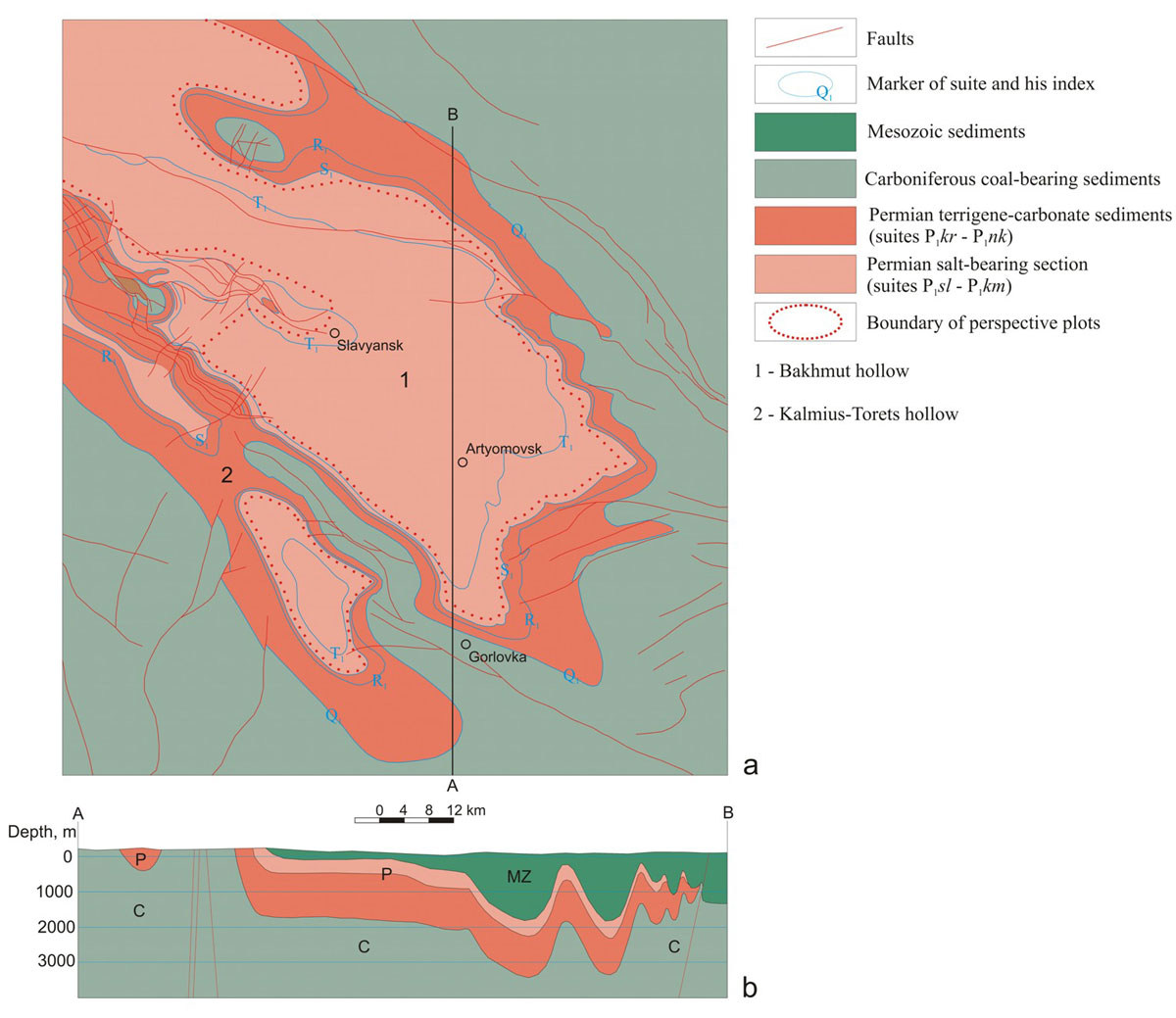> Storage in deep unmineable coal seams
1 Prospects for CO2 geological storage in the Donbass
Injection CO2 in geological formations has more than thirty years of experience in raising oil and gas recovery beds. In addition, in recent years in different countries has conducted numerous studies on the CO2 geological storage. As a long-term CO2 storage are considering mainly porous or fractured sedimentary rock (collectors), bounded on the surrounding mountain environment and the earth's surface impermeable or virtually impermeable rocks (waterproof rock or cap rock) [1].
There are three basic types of formations where possible CO2 geological storage: depleted or are in a stage of exhaustion, oil and gas reservoirs, which lie deep saline formations, and unmineable coal seams. Among other possible options of geological formations are considered as basalt formations and organic rich shales, but their potential is still poorly understood.
The success of CO2 geological storage method is confirmed by experiments conducted at different times, companies MRCSP, MGSC, SECARB, SWP, WESTCARB, Big Sky, PCOR (USA), as well as projects in Weyburn, Fenn Big Valley (Canada), Sleipner (Norway ), Yubari (Japan), Qinshui Basin (China) and others [1, 2-5].
Search and selection of geological structures and horizons that can serve as long-term CO2 storage in oil and gas pools is based generally on the results of previous exploration and geological survey.
2 Opportunities of CO2 geological storage in the Palaeozoic sediments
In Ukraine, there are large oil and gas province with a large amount of productive horizons. One of the largest oil and gas regions - the Dnieper-Donets basin (DDB) is located within the boundaries of two large structures - the Dnieper-Donets Deep and the Donetsk Coal Basin (Donbass) (Fig. 1).
Gas presence of the DDB basin is closely related to terrigenous sedimentary rocks Middle-Upper Carboniferous and Lower Permian. Methane gas content of Donbass also associated with Carboniferous coal-bearing layer.

|
Fig. 1. Arrangement of the Dnieper-Donets oil basin (eastern part) and the Donetsk coal basin.
Figure in a complete size it is possible to look calling on a picture on the left
|
Results of previous exploration work has shown that the geological conditions DDB and Donbass most promising with respect to the gas-bearing areas are the areas with the sediments preserved hydrochemical in Lower Permian age [6]. The important role of hydrochemical deposition is to their good insulating properties (alternating impervious to oil and gas layers of rock salt, anhydrite and gypsum dense). It is also important hydrochemical location of deposits in the upper part of a major sedimentary cycle, lithofacies composition which is dominated by rocks with good reservoir properties.
These factors, combined with large capacity gas permeable sedimentary rocks have created favorable conditions for the free migration of hydrocarbons and their concentration under the impenetrable veil of hydrochemical deposition. In the Donbass of the Lower Permian hydrochemical sediments developed in the north-western part of the borders Bakhmut and Kalmius-Torets hollows (Fig. 2a).

|
Fig. 2. Pre-Mesozoic sediments north-western part of the Donbass:
a) Geological map;
b) Geological section along the line A-B.
Figure in a complete size it is possible to look calling on a picture on the left
|
In structure Bakhmut and Kalmius-Torets hollows involved three structural horizons: the Paleozoic, Mesozoic and Cenozoic (Fig. 2b). Mesozoic and Cenozoic structural horizons are unpromising for CO2 geological storage. This is due to their low power (typically less than 500 m) and the bedding in the upper part of the sedimentary cover without gas-tight cap. Paleozoic structural horizon, which occurs under the cover of Mesozoic and Cenozoic sediments is promising for studying the possibilities of CO2 geological storage.
This is confirmed by its high potential gas content, established as a result of numerous studies and exploration work in opposite directions. For example, analysis of the geological structure and gas presence of the northern side Bakhmut hollow in UKRNIIGAS showed that the three structural layers is potentially gas bearing Paleozoic [7].
Palaeozoic structural horizon in Donbass consists of sediments of Permian, Carboniferous and Devonian systems. Permian system is represented by the lower division in the Asselian and Sakmarian stages.
Carboniferous system is represented in full and is a continuous section of the coal-bearing strata in the main. The deposits of the Devonian system lie at great depths (typically more than 5 km) and come to the surface in the form of a narrow strip in the south-western outskirts of the Donbass.
3 Criteria for process of CO2 geological storage
An important aspect in assessing the possibilities of CO2 geological storage in any pool is to determine the quantitative values of the criteria for the storage process:
- Reservoir and gas volume parameters of the rocks:
The most important parameters of reservoir properties of sandstones and gas volume are: open porosity, the degree of filling of pores with gas, moisture, permeability. Open porosity characterizes the capacity of the sandstone, available fluids and does not reflect the nature of the fluid. We can say that the open porosity alone can be used only in the theoretical ideal cases, when the pore space is filled rock water and gas. The reality on the reservoir properties of sandstones and affect many other factors. For example, the methane gas content of sandstone is heavily dependent on their moisture. Research results on some of the Donbass mines show that the degree of filling of pores with gas above 50% (industrial methane gas content) have a sandstone with moisture content less than 2% and open porosity in the range 7-11% [8]. It should be noted that the reservoir properties of sandstones and other clastic rocks of Donbass in respect of carbon dioxide are still unknown. It is unknown how the CO2 will depend on reservoir properties of sandstones from the above parameters. To assess the potential CO2 reservoir sandstones of Donbass to carry out a complex of experimental studies.
- Permeability insulation for gas:
Permeability of cap rock is not only the physical properties of the constituent species, but also its integrity. In case the reservoir geological faults insulator for gas their properties are significantly reduced.
- Maximum and minimum depth of CO2 sinks:
The minimum depth of CO2 sinks is determined by pressure and temperature at which the CO2 goes into the liquid phase and is approximately 800 m. The density of CO2 under these conditions will be within 50-80% of the density of water, which is comparable with the density of certain types of crude oil [1]. This constraint sets a minimum depth of the reservoir horizons and together with other criteria to be used in determining the prospective sites for CO2 sinks. However, please note that this value was obtained in the basins with different geological conditions, and in the Donets Basin depth comparable with the thermo-baric parameters may be different. The maximum depth of the reservoir is determined by the economic profitability and technological opportunities.
4 Processes CO2 discharge and storage
We will consider possible options for CO2 discharge process and subsequent storage in the Donbass:
- Injection CO2 into non-gas-contain horizons, with the properties of collectors:
In the upper Paleozoic sedimentary deposits of Donbass known horizons, with good reservoir properties, but do not have the gas content. These horizons can theoretically be used as a CO2 reservoir.
- Injection CO2 into coal seams and coal-bearing rocks can accommodate for the increased Extraction of Coal Bed Methane (ECBM):
At this point it is assumed that the industrial gas content have breed with the degree of filling of pores with gas for more than 50%. Extraction of gas from reservoirs with lower gas content is not economically profitable, but this estimate may change in the future when new technologies. One such technology is to ECBM by its displacement of rock forced through the holes with compressed CO2 [1]. At the same time solves two critical issues: increasing flow rates of natural gas methane and recovery CO2. In the case of economic efficiency of the process non-industrial gas manifestations (the degree of filling of pores less than 50% gas) can be quoted as a deposit. The lower limit of bearing capacity for such deposits will be determined by cost-effectiveness of their development with the use of ECBM. In the development of gas fields in the coalfields of time that will inevitably depletion and cessation of mining. The share of gas remaining in the reservoir can be quite large. Increased production rate of methane depleted horizons with use of ECBM can extend their service life and increase gas recovery.
- Injection CO2 in the exhaust manifolds:
Completely spent horizons are often used as temporary storage of natural gas. Such storage may be used for long-term CO2 storage. Given that the development of methane from coal mines of Donbass is in its infancy, the implementation of this option is possible in the future at a high level of development of the gas industry in region.
The first two options are relevant at the moment, especially considering that in Donbass region known horizons of sandstones with large reserves of gas, non-industrial, as well as sandstones and siltstones, non-methane gas content. According to recent data, the total gas-bearing potential only one Bakhmut hollow may reach 200 billion m3 of natural gas [7], and therefore the ECBM is one of the most promising areas of CO2 geological storage in Donbass.
5 Promising areas of CO2 geological storage
Based on the results of foreign CO2 geological storage and extensive information on the geological structure of the Donets Basin, outlines the boundaries of promising areas for further study of their potential for CO2 geological storage. Sites are located in Bakhmut and Kalmius-Torets hollows within the boundaries of the powerful insulating cap salt-bearing deposits of the Lower Permian (Fig. 2a).
According to the drilling and geophysical surveys, directly under the gas-tight rocks overlain by terrigenous coal-bearing strata powerful upper - middle carbon, which contains numerous thick layers of rocks with good reservoir properties, in some cases - high methane gas content, as well as the seams of coal. An important point also is that because of the high-powered cover of Permian and Mesozoic-Cenozoic deposits in the territories Bakhmut and Kalmius-Torets hollows, the coal seams are developed there.
The boundaries of promising areas are identified and require clarification. Within the Bakhmut and Kalmius-Torets hollows there are sites, complicated by numerous faults, which affect the integrity of a gas-tight cap and create the possibility of migration of liquid and gaseous substances to the surface. In addition to faulting in the northwestern part of the Bakhmut hollow developed salt-dome structures of Devonian age, which penetrate the overlying Paleozoic and Mesozoic, and in combination with tectonic disturbances are also areas of migration of liquid and gaseous substances to the surface. In this regard, further quantitative assessment of opportunities the CO2 geological storage in Bakhmut and Kalmius-Torets hollows should be given a thorough analysis of the structural-tectonic structure.
6 Objectives quantify features of CO2 geological storage
Based on the above material compiled a list of priority tasks that must be addressed to quantify the opportunities CO2 geological storage in Donbass:
- Quantify the criteria of the process of CO2 geological storage for geological and hydrogeological conditions of the Donbass and allocation of prospective sites;
- Geochemical, structural-tectonic and hydrogeological testing of promising areas, quantification values of reservoir parameters of sedimentary rocks, the allocation of gas traps, etc.;
- Analysis and summary of the results, the selection of promising horizons of reservoir within the prospective sites and calculate their CO2 - the capacity potential.
Meeting these challenges will assess not only the potential CO2 volume Donets Basin, and the possibility of increasing the yield and methane in the process which began commercial development of gas resources of Donbass.
References:
[1] IPCC, 2005: IPCC Special Report on Carbon Dioxide Capture and Storage. Prepared by Working Group III of the Intergovernmental Panel on Climate Change [Metz, B., O. Davidson, H. C. de Coninck, M. Loos, and L. A. Meyer (eds.)]. Cambridge University Press, Cambridge, United Kingdom and New York, NY, USA, 442 pp.
[2] Carbon sequestation atlas of the United States and Canada. National Energy Technology Laboratory. U.S. Department of Energy. Office of Fossil Energy. 2007.
[3] William D. Gunter, Mathew J. Mavor, John R. Robinson / CO2 Storage and Enhanced Methane Production: Field Testing at Fenn-Big Valley, Alberta, Canada. – http://uregina.ca
[4] The Sleipner Project and Monitoring Experiences. – http://ns.energyresearch.ca
[5] IEA Weyburn CO2 Monitoring and Storage Project Weyburn, Saskatchewan, Canada. – http://www.netl.doe.gov
[6] Chirvinskii M. / The limits of distribution, mode of occurrence, and gas and oil presence chemogenic formations of the Lower Permian of the Dnieper-Donets Basin. Materials on the geology and gas-bearing Lower Permian deposits of the southern Russian platform. – Kharkov, 1961. – P. 51-57. (RUS)
[7] Goryainov S., Lakoba M., Pavlov S. / The estimation of the new litologikal traps gasogeniks perspectives on the northern side of Bakhmutskaya hollow // Ukrainian Geologist. – 2011. – No. 2(34). – P. 99-102. (RUS)
[8] Shkuro L., Gorbachev G. / Rate of gas-contain of sandstones is in the mountain making taking with indicator are tahe account of porosity and humidity // Geotechnical mechanics. – 2010. – No. 88. – P. 118-123. (RUS)
|





